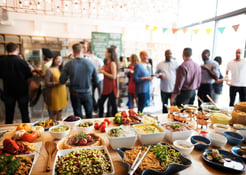In 2018, William Silbernagel set out on a mission – to create the fried chicken sandwich of his dreams, and perfect a recipe he could sell to the masses. After sharing a few test rounds with his friends Greg Best, a seasoned restaurant operator, and Bart Sasso, a fellow restaurant owner and branding expert, the three quickly teamed up, with plans to combine their skills and open a fried chicken sandwich joint in Atlanta. This led to months of location-scouting. And eventually they settled on a 750-square-foot spot, securing investors along the way who pledged to help fund it.
But then the pandemic hit, and quickly plans were paused. The team’s investors dropped out, leaving them with an unfinished build-out and a lack of funds to complete it.
So they pivoted. Rather than open their concept, How Crispy Express, as a restaurant, the trio started with pop-ups, partnering with a beer joint across the street, and also operating out of Best’s and Sasso’s restaurant, Ticonderoga Club. Almost immediately, the buzz started to grow. Lines quickly formed at nearly every How Crispy pop-up, eventually attracting new investors who’d help them in finally opening the brick-and-mortar version.
We sat down with Sasso to chat about their pop-up experiences and strategies, and how the tactic can help play a role in building a successful restaurant brand.
You were just getting How Crispy off the ground when the pandemic hit – what was your initial reaction when you found out your investors were backing out?
It was unfortunate, but we understand the hesitance of getting involved in a restaurant at that time. We’re veterans in this industry, and so you always anticipate a curveball, and you just continue on, and ultimately you’ll attract the right investors.
At this point, are you keeping the 750-square-foot space you lined up?
Yeah, there was an LOI on the spot. Rent started at a certain point, but it wasn’t during the entirety of the pop-ups. The landlord was understanding.
What went into deciding to start doing pop-ups out of other locations?
With Will committing full-time to do this, he needed a way to start generating revenue. But the plan really was always to get the name out before just cold-opening.
So first and foremost, we wanted to gain buzz. Second of all, the property in Summer Hill was essentially a white box, and we needed investment to finish that box. So we started leveraging relationships and friendships in the industry to pop up in other people’s space.
So pop-ups were always the plan. Can you share what you see as their greatest value?
The main strategy is to familiarize people with your food and your brand, and create a name for yourself. It gives you something to talk about on social media so that when you open your restaurant, you’re not communicating to zero followers.
With pop-ups, there’s the scarcity factor. If you’re only serving a limited amount of something, because you only have the resources to do so, and it’s something that’s good enough to attract some buzz, then it becomes a hot item. We pretty quickly experienced lines before we’d open, based on that fear of missing out notion. Long-term, that’s not a way to build a successful business. It’s our intention ultimately to serve as many chicken sandwiches as we can, but in the beginning, your resources are very limited, and you can leverage that to build a following and a brand.
You can also work out the kinks, see what’s resonating with people and what’s not. And you’re also working things out like the bun, the seasonings for the different sandwiches, the sides and what goes with what. The menu that we opened the brick-and-mortar with was largely informed by what was successful with the pop-ups.
At one point during the pandemic, you were using a rope and a plastic bucket to drop orders from a window. How did that idea come about?
We had partnered with Halfway Crooks, which is a brewery and taproom across the street, and we were using their upstairs patio. I think Greg had the idea. He just knows what resonates with people. He’s a bit of a showman. But there was also the functionality of delivering food to people at that time in a way that was safe, when people were coming and were nervous. So it became a cheeky way to deliver food with no-contact.
While we weren’t dismissing the severity of the situation, we’re always looking for ways to brighten people’s day, even in a difficult time. We’re hospitalitiarians. It becomes this iconic thing, it becomes fun. People are taking photos. And now the bucket’s hanging in our space, so you’re building this narrative with your audience.
How crucial would you say the pop-ups were to actually launching the full restaurant?
I don’t know. If you had told us we needed to start this cold, we would’ve figured out how to do that. That’s the way we opened Ticonderoga Club. We didn’t even announce the name until the week we were opening. And there’s something to that, too. It’s like when Drake drops an album out of nowhere, and that can cause a big splash. But then there’s also the model where you trickle out a couple singles, and the album comes later.
It’s really about operator to operator, concept to concept, and your goals. For How Crispy, it was about making lemonade out of lemons at the beginning of the pandemic. We thought, “If we have all this time before we can open, how do we start serving people now?” If the pandemic never happened, would we have done as many pop-ups? Probably not. But again, it’s all about being flexible.
The pop-ups kept the brand afloat and ultimately attracted investors. And it was through investment that we were able to fund the build-out for the brick-and-mortar. With investors, they need to see commitment, and commitment in a very difficult time – that’s what business is, that’s what entrepreneurship is.
Were you surprised to attract such a buzz?
In some ways, no. I think we’re all very good at what we do, and when we tasted Will’s sandwich, we knew it was really good, and if it could be consistent and we could create a fun brand, it would work. But there’s the brand layer – creating a brand that’s approachable, fun, interesting. And then your operations have to be completely dialed in so people’s experiences are consistent. There’s all these little things that have to work harmoniously to be successful and to gain that following. So it’s very difficult, and I think we were surprised at how quickly and passionately people latched on.
Can you share any advice on how to create a successful pop-up? Are there any key factors that you think really drive an audience?
The most important thing is to have a great, consistent product, with excellent hospitality and clear communication. That’s the bedrock of a successful pop-up, but also the business you’re going to open later. If those things are dialed in, then you can add the flourishes on top. If the chicken’s not good, then dropping it down with a bucket isn’t going to work.
People need to know where you are, what the price is, and how they get it. Being vigilant on social media is important. If people have a question or a problem, we’d address it the next time around. It’s never going to be perfect, of course, but it’s essential to pay attention to feedback and utilize it. Especially with a pop-up, which is fluid.
What about creating really limited time windows – do you think that’s essential to drawing attention?
I’d say “yes”. A limited time window is better than an open-ended time window for anything. It’s about that clear communication, rather than telling people to “just show up whenever”.
But I’d say it shouldn’t be your primary focus to drive a sellout every time. People can smell that a mile away. They know a gimmick. But a limited window focuses a window of availability to make sure people are getting in there and buying the product, because you don’t want to waste the product either – it’s precious.
How Crispy maintains a considerably playful social media presence. Can you talk about the strategy behind that and how that ties into the brand and business?
Will is a playful guy. I have an agency that I operate alongside these restaurants, and it’s so important with what we do to create brands that are bespoke to the people who are going to be operating them, a brand that’s a manifestation of their personality. If I were to go away, and I created this brand for Will, I’d want him to know what to do with it after I leave.
When we work with a client that we don’t know, we get to know them immediately. Will is someone I’ve known for a long time. We joke a lot, we text a lot, we laugh at the same memes. And I wanted to create a brand that spoke to that and told other people who Will was.
There was a lot of collaboration – we went through several rounds of branding. But we came up with this fun, sleepy chicken character that’s deep fried. The concept was elevated fast food. We wanted the branding to feel familiar, like a fast food spot that had been around a long time. And that’s a simple color palette, punchy colors, playful graphics. We also love a mascot. A mascot in fast food is a thing everywhere, so that was important.
How large of a role do you think branding plays in the success of a restaurant?
I think it’s really important. But I don’t think it’s as important as everything underneath the surface. Hospitality and what you’re offering is the bedrock, and a great brand can’t fix that. But if you can have it all, that’s when the magic happens.
Branding helps you reach more people, and in today’s day and age, people are much more knowledgeable, savvy, and critical of branding, and that has a lot to do with social media. People do make decisions on branding now. Restaurants have become something that people think are an extension of their personality. People like to share on social media where they’re eating, the neon signs, the wrapping paper around what they’re eating. So branding can be your first impression, but once you’ve hooked the customer and they’re intrigued, your food and hospitality have to be as good as that branding.
Tell me about the Free Nuggies campaign, and the decision to give away nuggets at your brick-and-mortar.
We wanted to get people to order online. It helps us to manage flow. We don’t want a huge line outside. We want to be a place for a quick lunch. So the free nuggets were kind of like, “Look, you can order online and skip the wait.”
With the pop-ups, you learn it’s really about listening to people and taking in feedback. It resonates when people say, “I drove all the way down here to get a sandwich, and you guys were sold out an hour after you opened.” That’s disappointing. It taught us not to just throw open our doors and say, “Come and get it.” There are plenty of other amazing chicken sandwiches in Atlanta. If they can’t get a hold of what they want, they’ll move on. We were bombarded the first week we opened, and we were panicking. I changed the hours two or three times in that one week.
How large do you envision the concept to grow?
Multiple locations has always been the vision, when the time comes. First, we want to get the spot we have open operating at full capacity, serving as many people as possible, and making as many customers satisfied as possible.
We opened in a limited capacity – hiring is impossible right now. As we’re able to find the right people, we’re expanding our hours. We’re open on Sundays now, which is really fun because Chick Fil A is closed on Sundays. And most Atlantans will tell you Sunday is the day they want a chicken sandwich the most.
What excites you most about growing?
Serving more people, making a bigger brand. It’s why we do what we do – serving people delicious food and helping them have fun while we do it. I know it sounds corny, but it’s not. It’s what we do. And to do it in multiple locations across the city would just be so fun. I think there’s no limit on where How Crispy could go.
Grace Dickinson is a reporter at Back of House. Send tips or inquiries to grace@backofhouse.io.





